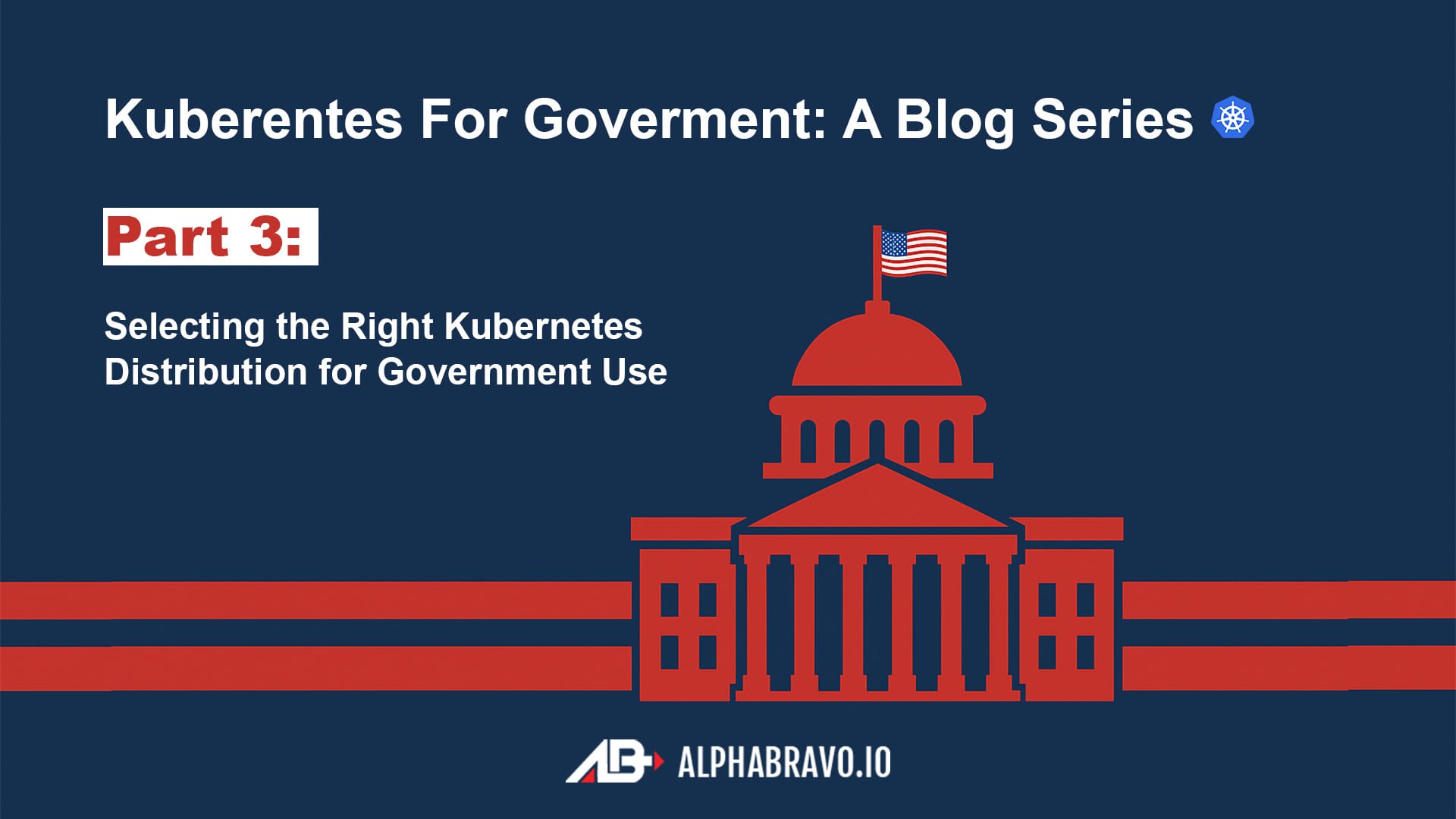Selecting the Right Kubernetes Distribution for Government Use (Part 3)

In the high-stakes world of government IT, where security clearances are sometimes easier to obtain than software approvals, choosing the right Kubernetes distribution is a critical mission. Your selection could mean the difference between smooth sailing through Authority to Operate (ATO) assessments or finding yourself in a compliance quagmire that makes tax code look straightforward.
As we navigate the Kubernetes landscape together, we'll explore how vanilla Kubernetes, OpenShift, and Rancher measure up against the rigorous demands of federal agencies. Pour yourself some coffee (in a FIPS-compliant mug, of course) as we dive into the world where container orchestration meets government regulation.
The Government's Kubernetes Shopping List
Before we compare distributions, let's understand what Uncle Sam is looking for in a Kubernetes platform:
FIPS 140-2/140-3 Compliance
The Federal Information Processing Standard (FIPS) 140-2 defines cryptographic requirements that federal IT systems must meet. For Kubernetes, this means validated cryptographic modules at every level of the stack, from the container runtime to network communications.
FIPS compliance can be implemented using a "FIPS wall" approach, which creates "a compliant boundary that is secured at external points of contact (known as 'touch points')." Within this boundary, communications between nodes are secured with IPSec encryption, while traffic within nodes remains in-memory.
STIG Readiness
Security Technical Implementation Guides (STIGs) are the gospel of government system hardening. The Defense Information Systems Agency (DISA) publishes these guides to establish security baselines for IT products.
Applying STIGs is traditionally a labor-intensive process. As one expert notes, "STIGs are important because they produce technical hardening guides that can be trusted... applying a STIG dramatically decreases guesswork for IT staffs".
Impact Level Compatibility
DoD classifies systems by Impact Levels (IL) based on the sensitivity of data and the consequences if compromised:
- IL2: Non-controlled unclassified information
- IL4: Controlled unclassified information
- IL5: Controlled unclassified information requiring higher protection
- IL6: Classified information up to SECRET
Your Kubernetes distribution needs to support the appropriate Impact Level for your workloads.
Zero-Trust Architecture
Modern government security frameworks emphasize Zero-Trust principles, where nothing is implicitly trusted, and verification is required from anyone trying to access resources.
Vanilla Kubernetes: Plain but Powerful
When we talk about "vanilla" Kubernetes (a term that would make government procurement officers raise an eyebrow — "Is the vanilla sustainably sourced?"), we're referring to the basic, unmodified Kubernetes implementation without vendor-specific enhancements.
Vanilla Kubernetes consists of six core components:
- kube-apiserver - The core control point where everything interacts
- kube-scheduler - Matches new pods to nodes based on various factors
- kube-controller-manager - Contains four bundled controllers
- cloud-controller-manager - Emulates controller-manager features for cloud environments
- kubelet - The node-level supervisor that manages containers
- kube-proxy - Ensures proper network traffic management
Government Fit Assessment
Vanilla Kubernetes is like showing up to a formal government function in jeans and a t-shirt — technically present, but missing expected formalities. While it provides the foundation, it lacks out-of-the-box compliance with government requirements.
When using DIY Kubernetes, you need to "download and implement multiple STIGs for the underlying operating system, Kubernetes and harden any other components they include." This approach requires implementing a staggering 468 STIG items when combining RHEL 8 and Kubernetes STIGs.
On the positive side, vanilla Kubernetes offers maximum flexibility and no vendor lock-in. For agencies with specialized needs and robust in-house security expertise, this might be the preferred option. You'll just need to build your own FIPS-compliant cryptographic modules and STIG implementation — perhaps in your copious spare time between congressional budget hearings.
OpenShift: Red Hat's Government-Ready Platform
Red Hat OpenShift takes a different approach by providing a comprehensive container platform with built-in security features tailored for enterprise and government use.
OpenShift significantly reduces hardening requirements compared to vanilla Kubernetes. While DIY Kubernetes plus RHEL requires addressing 468 STIG items, OpenShift has a mere 83 items, with only 7 in the highest priority category (CAT I).
This dramatic reduction stems from OpenShift's use of Red Hat Enterprise Linux CoreOS (RHCOS), a lightweight, immutable, container-specific operating system. As NIST SP 800-190, Application Container Security Guide recommends: "Use container-specific host OSs instead of general-purpose ones to reduce attack surfaces".
Government Fit Assessment
OpenShift shines in government environments due to its:
- DISA-published STIG for OpenShift Container Platform 4.12
- Built-in compliance automation through the Compliance Operator
- FIPS 140-2 support
- Immutable infrastructure model reducing attack surface
As an official publication states, "Red Hat OpenShift is designed to support how government agencies work in a digital world, enabling Kubernetes-based applications to be developed and deployed more quickly while prioritizing security posture and compliance measures".
OpenShift is like the government employee who shows up with all paperwork in triplicate, properly filled out, and alphabetized — ready for any audit or inspection. The downside? Like government paperwork, it comes with overhead in terms of resources and potentially higher costs.
Rancher Government Solutions: Purpose-Built for Federal Needs
Rancher Government Solutions (RGS) has positioned itself as a specialist in the federal Kubernetes space, with offerings specifically designed for government use.
Rancher has the distinction of being "the only Kubernetes management platform to receive such a designation" from DISA, with a validated STIG for Rancher Multi-cluster Manager (MCM). This validation allows "U.S. Government and specifically Department of Defense (DoD) military agencies to deploy and use the Rancher MCM 2.6 on DoD network systems".
RGS has furthered its government focus with Carbide, described as "an add-on support service to the existing Rancher products suite that delivers cutting-edge capabilities to ensure software supply chain security and support federal security compliance requirements".
Government Fit Assessment
Rancher's government-specific features include:
- DISA-validated STIGs for both Rancher MCM and RKE2 distribution
- STIGATRON - An automated compliance tool within Carbide that validates downstream clusters against STIG requirements
- Software Supply Chain Security with Carbide Secured Registry
- Edge deployment capabilities critical for tactical environments
RGS focuses on "Enhanced Security & Compliance," "Expert Guidance," "Mission-Critical Reliability," and "Operational Efficiency" — all key concerns for government agencies.
Rancher in government is like having a dedicated sherpa for climbing Mount Compliance — specialized tools and knowledge for navigating the specific challenges of federal IT environments.
Distribution Comparison Matrix
Let's compare these three options across key government requirements:
| Feature | Vanilla Kubernetes | OpenShift | Rancher Government Solutions |
|---|---|---|---|
| FIPS 140-2 Compliance | Requires manual implementation | Built-in support | Built-in with RKE2 |
| STIG Availability | Generic K8s STIG (93 items) | OpenShift-specific STIG (83 items) | DISA-validated STIGs for MCM and RKE2 |
| Compliance Automation | None built-in | Compliance Operator | STIGATRON |
| Air-gapped Operations | Requires additional tools | Supported | Full airgap capability with Carbide |
| DoD Validated | No | Yes | Yes - only K8s platform with DISA validation |
| Edge Deployment | Requires customization | Supported | Purpose-built edge capabilities |
| Base OS | Various/Your choice | RHEL CoreOS (immutable) | RKE2 OS (hardened) |
| Learning Curve | Steep for secure implementation | Moderate | Moderate |
| Support for Government | Community/DIY | Red Hat Government | Rancher Government Solutions |
Selecting Your Government Kubernetes Companion
Choosing the right Kubernetes distribution for government use ultimately depends on your specific agency requirements, existing infrastructure, and team capabilities. Here are some decision factors to consider:
Classification Level
For highly classified environments (IL5/IL6), pre-hardened distributions like OpenShift or RKE2 with their respective STIGs provide the most direct path to compliance.
Existing Relationships
If your agency already runs Red Hat Enterprise Linux, the pathway to OpenShift may be smoother. Likewise, if you're already using Rancher for container management, RGS's offerings provide a natural extension.
In-house Expertise
Vanilla Kubernetes requires significant security expertise to properly implement in government environments. Only choose this path if your team has deep Kubernetes security knowledge and the time to implement and maintain all security controls.
Automation Requirements
Both OpenShift and Rancher offer automation tools for compliance (Compliance Operator and STIGATRON, respectively). These can dramatically reduce the ongoing burden of maintaining compliant clusters.
Tactical Edge Requirements
For deployments that need to function in disconnected, tactical environments (think that soldier with a Kubernetes cluster in a backpack), look for distributions with robust edge capabilities and minimal resource requirements.
The Kubernetes Classified Mission Continues
As we wrap up our tour of Kubernetes distributions for government use, remember that selection is just the beginning. Even the most security-focused distribution requires proper configuration and ongoing maintenance to remain compliant in government environments.
In our next installment, we'll get our hands dirty with practical implementation of baseline security controls. We'll explore how to harden your chosen Kubernetes distribution to meet DISA STIG requirements, implement RBAC policies that would make access control officers proud, and configure network policies that could give even the most determined adversaries a headache.
Whether you're running vanilla Kubernetes with a side of custom security controls, patrolling your infrastructure with Red Hat OpenShift, or wrangling containers with Rancher Government Solutions, you'll find actionable guidance to elevate your cluster's security posture to a level that would pass muster even in the Pentagon's most scrutinizing security reviews.
Stay tuned for "Hardening Kubernetes: Implementing Baseline Security Controls" – where we'll move from selection to action in securing your government Kubernetes deployment. By the time we're done, your clusters will be so secure, even your agency's red team will need to fill out forms in triplicate just to get access.

